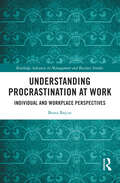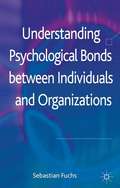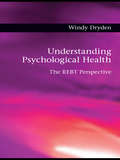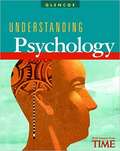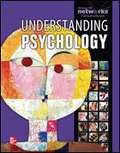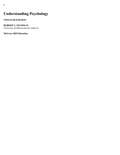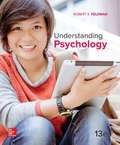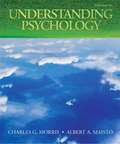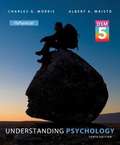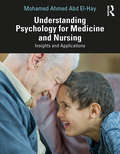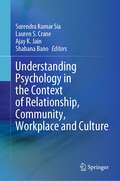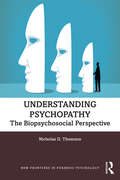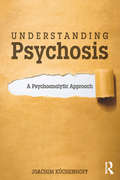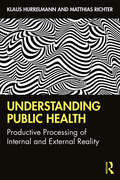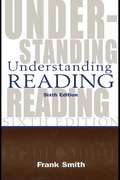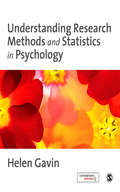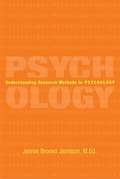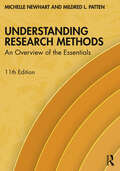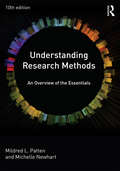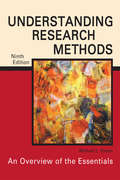- Table View
- List View
Understanding Procrastination at Work: Individual and Workplace Perspectives (ISSN)
by Beata BajcarUnderstanding Procrastination at Work focuses primarily on procrastination in the workplace, and offers a synthetic and comprehensive review of major theoretical concepts and empirical findings on general procrastination and its specific manifestations, causes, and consequences in the workplace. Building on theoretical insights and empirical research, the monograph proposes and empirically verifies an expanded conceptual framework that integrates individual and work-related factors that contribute to work procrastination and mechanisms explaining this phenomenon. It sits at the intersection of two disciplines, integrating psychological and management knowledge so that a wider audience may benefit from its content. It thus sheds more light on sources and explanatory mechanisms underlying procrastination as a universal behavior in the work setting, with meaningful implications for individuals and organizations alike. Overall, the monograph can serve as a contemporary compendium of knowledge that enables the scientific community and organizational practitioners to better understand procrastination behavior and its implications in professional settings. From the theoretical and empirical perspectives, the monograph provides practical cues to develop prevention and intervention strategies to effectively address and manage procrastination and enhance employee productivity in the organization.
Understanding Psychological Assessment
by Devasena Desai Jan J Laak Meenakshi GokhaleUnderstanding Psychological Assessment presents a comprehensive overview of the history of psychological assessment and its domains of application. It gives a realistic account of how psychological theory, measurement, and instruments can help the practitioner in understanding, explaining, and predicting a client's problem or question. Using a systematic framework, it also reflects on the history, needs, methods, and consequences of psycho-diagnosis. Using this book as a guide, the practitioners and the students will be able to conduct a comprehensive assessment of the client.
Understanding Psychological Bonds between Individuals and Organizations
by Sebastian FuchsOrganizations operating in competitive environments habitually seek ever-new avenues to increase and optimize the performance of their individual employees. One popular device to increase employees' performance, especially those elements of performance that are left to the discretion of an individual, refers to the idea of creating a strong, meaningful psychological bond between an individual and an organization. Understanding Psychological Bonds between Individuals and Organizations looks at precisely this device and proposes a novel, integrated and comprehensive model which investigates the different mechanisms that help to explain such psychological bonds.
Understanding Psychological Health: The REBT Perspective
by Windy DrydenThis book draws on Rational Emotive Behaviour Therapy (REBT) - which focuses on resolving emotional and behavioural problems and disturbances and enables people to lead happier and more fulfilling lives - to provide an understanding of psychological health. Each chapter looks at an important aspect of psychological health and then discusses it in relation to the REBT approach. Divided into two parts the book looks first at how people can remain psychologically healthy in the face of adversity and then goes on to discuss how these healthy philosophies underpin certain key areas of psychological health. As such, topics of discussion include: flexibility acceptance self-motivation resilience. Understanding Psychological Health will be of great interest to all therapists in both practice and training.
Understanding Psychology
by Richard A. Kasschau Glencoe McGraw-Hill Staff MacMillan/McGraw-Hill StaffThe overall philosophy of Understanding Psychology is to bring complex psychological concepts to students' lives. The goal of this program is to make psychology relevant, fun, interesting, and even exciting, making it approachable. <p><p> The Understanding Psychology program was designed to help students understand how this subject is part of their day-to-day lives. Research in assessment and APA literature was reviewed. The program's authors, academic consultants, and experienced Social Studies educators reviewed the assessment plan for Understanding Psychology. Understanding Psychology includes a variety of assessment instruments to support instruction. The test booklet provides three-part chapter tests: Matching, Multiple Choice, and Essay.
Understanding Psychology
by Richard A. KasschauThis book offers a rigorous presentation of psychological science with numerous and immediate examples.
Understanding Psychology
by Richard A. KasschauConnect complex psychological concepts to real life Understanding Psychology simplifies complex psychological concepts for students. The program’s philosophy is to make psychology relevant, fun, interesting, and approachable. Understanding Psychology is an interactive book with hands-on activities, case studies, current issues, and readings about the field of psychology.
Understanding Psychology
by Robert S. FeldmanThe new edition uses “HeatMap” technology to advise the revision. Systematic and precise feedback from thousands of students was anonymously collected using LearnSmart™. Because virtually every paragraph in the previous edition is tied to several questions students answer in LearnSmart, the author was able to see where students struggled most…the “hot spots”…and in turn refine and update these areas to be more clear, more concise, and more impactful.
Understanding Psychology (13th Edition)
by Robert S. FeldmanStudents First. Designed for student success, Feldman provides students with a powerful learning framework to help them connect, engage, and feel excited about psychology. Using a revolutionary revision process, Understanding Psychology is a fully integrated learning system that brings the "Students First" goal to a new level. With the adaptive learning program, SmartBook(tm), every student has a unique experience personalized to their needs. The new edition has continued to use the "HeatMap" technology to advise the revision. Systematic and precise feedback from thousands of students was anonymously collected using LearnSmart(tm). Because virtually every paragraph in the previous edition is tied to several questions students answer in LearnSmart, the author was able to see where students struggled most. . . the "hot spots". . . and in turn refine and update these areas to be more clear, more concise, and more impactful. The 13th edition continues with Feldman's accessible pedagogy and hallmark research, as well as his modules-within-chapters format that is both manageable for students and allows every professor the flexibility to assign and cover what they want.
Understanding Psychology (9th Edition)
by Charles G. Morris Albert A. MaistoThis textbook presents a scientific, accurate, and thorough overview of the essential concepts of psychology in engaging language that the average reader can easily comprehend. Topics include the science of psychology, the biological basis of behavior, sensation and perception, states of consciousness, learning, memory, cognition and mental abilities, motivation and emotion, life-span development, personality, stress and health psychology, psychological disorders, therapies, and social psychology. For anyone who is interested in introductory psychology.
Understanding Psychology With Dsm-5 Update
by Charles Morris Albert MaistoUnderstanding Psychology, 10/e, presents a scientific, current overview of the fundamental concepts of psychology. The authors highlight enduring issues that unite all subfields of psychology: Person-Situation, Nature-Nurture, Stability-Change, Diversity-Universality, and Mind-Body. These enduring issues help readers learn the surprising unity and coherence of the diverse and exciting science of psychology. MyPsychLab is an integral part of the Morris/Maisto program. Engaging activities and assessments provide a teaching and learning system that helps students apply psychological concepts to everyday life. With MyPsychLab, students can watch videos on psychological research and applications, participate in virtual classic experiments, and develop critical thinking skills through writing. This title is available in a variety of formats - digital and print. Pearson offers its titles on the devices students love through Pearson's MyLab products, CourseSmart, Amazon, and more.
Understanding Psychology for Medicine and Nursing: Insights and Applications
by Mohamed Ahmed Abd El-HayThe book presents a comprehensive updated approach to current psychological knowledge to facilitate a rapid review of the major subjects in psychology in medicine and to stimulate further detailed study. The book is divided into five Parts. Part One provides an elaborate background of the various sub-disciplines of psychology, the various theories and schools of thoughts encompassing them. Part Two discusses the links between the physical and psychological state of being human. Part Three elucidates the basic psychological processes that shape human cognizance. Part Four talks about the different factors which influence the human psyche. Part Five discusses the various aspects of clinical psychology and their implications for the physical well-being of people. Understanding Psychology for Medicine and Nursing distinguishes itself in providing a concise, clear understanding of most of the basic topics of psychology that are essential to all students of general psychology, but particularly to medical and nursing students, and to postgraduate trainees in psychiatry.
Understanding Psychology in the Context of Relationship, Community, Workplace and Culture
by Surendra Kumar Sia Lauren S. Crane Ajay K. Jain Shabana BanoThis book explores the significant deliverables of psychology to society in five sections: identity and relationship, psychology for gainful employment, psychology customized to the community, culturally embedded psychology and alternatives for maximizing psychology. The authors, social scientists of diverse nationalities, represent novel psychological methods, tools and procedures that can have immense social utility in strengthening the relationship and rejuvenating the community. The first section offers an in-depth perspective on the dynamics between identity and relationship. The second section encompasses psychology's contribution in addressing community-based issues like farmer suicide, cyberbullying, smartphone overuse, substance abuse and collective environmental behaviour. The authors in the third section have deliberated upon the behavioural issues pertinent for gainful employment. The fourth section delineates the influence of culture on specific psychological processes. The last section touches upon means beyond conventional strategies, techniques and approaches that may augment psychology's deliverability. The chapters in this book are based upon evidence-based scholarships from seven different countries. As such, it represents an invaluable resource for research scholars and academicians in psychology, human resource managers and mental health practitioners.
Understanding Psychology, Student Edition (Understanding Psychology Series)
by Richard A. KasschauConnect complex psychological concepts to real life Understanding Psychology simplifies complex psychological concepts for students. The program's philosophy is to make psychology relevant, fun, interesting, and approachable. Understanding Psychology is an interactive book with hands-on activities, case studies, current issues, and readings about the field of psychology.
Understanding Psychopathy: The Biopsychosocial Perspective (New Frontiers in Forensic Psychology)
by Nicholas D. ThomsonUnderstanding Psychopathy is an essential, accessible new guide on psychopathy and its development. Through the lens of the biopsychosocial model, Thomson explores a wide range of factors contributing to the development of psychopathy, from the genetic to the environmental, supported by the latest research into the disorder. Thomson examines psychopathy from all angles, analysing social, psychological and biological factors, in addition to the history and assessment of psychopathy, and links to violent crime. Theory and research are supported throughout with fascinating case studies. These case studies provide accessible and relevant examples for readers who are new to the field, and to those more familiar with psychopathy and its implications. Understanding Psychopathy is a brilliant resource for psychology students, researchers and practitioners in the criminal justice system alike, with grounding in forensic psychology, clinical psychology and criminology. The author is donating his royalties in full to Project EMPOWER, UK, a multidisciplinary initiative dedicated to enhancing prevention and intervention services to individuals and their families who experience intimate partner violence, sexual violence, domestic violence, or human trafficking.
Understanding Psychosis: A Psychoanalytic Approach
by Joachim KüchenhoffDo psychotic disorders make sense? Are psychotic symptoms amenable to interpretation? Understanding Psychosis: A Psychoanalytic Approach takes the various pathways to psychotic illness outlined by psychoanalytic clinicians and scholars and integrates them into a model that allows a systematic assessment of relevant psychodynamic dimensions in the diagnosis of psychotic disorders, and which serves as a guide to psychotherapy with psychotically ill patients. Joachim Küchenhoff reviews and integrates various psychoanalytic concepts and theories about psychosis into a multi-dimensional psychodynamic model that allows an assessment and understanding of the patient’s subjective experience, objective psychological capabilities, and interpersonal resources. Küchenhoff helps the therapist to establish a basic attitude in working psychodynamically with patients and to understand the dynamics of the therapeutic relationship. Understanding Psychosis also addresses specific issues that can arise in work with clients experiencing psychosis, including understanding imminent crises or precursor states, elucidating semiotic qualities in seemingly negative symptoms, differentiating the psychotic and a non-psychotic part of the personality and providing a dynamic approach to the psychopharmacological treatment. Clinical vignettes and three detailed case reports are included in the book. Understanding Psychosis will be an essential guide for psychiatrists, psychotherapists and psychoanalysts working with patients experiencing psychosis. It will also be of use to psychologists, and academics and students of psychotherapy, psychiatry and psychoanalysis for psychosis.
Understanding Public Health: Productive Processing of Internal and External Reality
by Matthias Richter Klaus HurrelmannThis book develops a new model of the genesis of health, on the basis of the interplay between genetic and environmental factors. Hurrelmann and Richter build upon the basic theories of health and the popular model of salutogenesis to offer a comprehensive interdisciplinary theory of health genesis and success: Productive Processing of Reality (PPR). The authors show that health is the lifelong dynamic process of dealing with the internal reality of physical and psychological impulses and the external reality of social and material impulses. To demonstrate this, the book is split into three interconnected parts. Part A analyses the determinants of health, providing an overview of the insights of current research and the impact of socioeconomic influences and gender on health. Part B covers public health, social, learning and coping theories, all of which understand health as an interaction between people and their environment. Part C draws on these four theories to outline PPR, stressing the interrelation between physical and mental constitution and the demands of the social and mental environment, and suggesting strategies for coping with these demands during the life course. Understanding Public Health: Productive Processing of Internal and External Reality will be valuable reading for students and researchers in psychology, sociology, educational science, public health and medical science, and for policymakers in public health.
Understanding Reading: A Psycholinguistic Analysis of Reading and Learning to Read
by Frank SmithUnderstanding Reading revolutionized reading research and theory when the first edition appeared in 1971 and continues to be a leader in the field. In the sixth edition of this classic text, Smith's purpose remains the same: to shed light on fundamental aspects of the complex human act of reading--linguistic, physiological, psychological, and social--and on what is involved in learning to read. The text critically examines current theories, instructional practices, and controversies, covering a wide range of disciplines but always remaining accessible to students and classroom teachers. Careful attention is given to the ideological clash that continues between whole language and direct instruction and currently permeates every aspect of theory and research into reading and reading instruction. To aid readers in making up their own minds, each chapter concludes with a brief statement of "Issues." Understanding Reading: A Psycholinguistic Analysis of Reading and Learning to Read, Sixth Edition is designed to serve as a handbook for language arts teachers, a college text for basic courses on the psychology of reading, a guide to relevant research on reading, and an introduction to reading as an aspect of thinking and learning. It is matchless in integrating a wide range of topics relative to reading while, at the same time, being highly readable and user-friendly for instructors, students, and practitioners.
Understanding Relational and Group Experiences through the Mmogo-Method®
by Vera RoosThis volume describes the development and application of the Mmogo-method® as a projective visual data gathering method, applied in different contexts and with different groups of people. The Mmogo-method® provides a more profound understanding of personal, relational and group experiences. "Mmogo" means togetherness in Setswana, one of the 11 official languages of South Africa. The Mmogo-method® is particularly useful in cross-cultural contexts and across age groups, and by allowing visual expressions of the self as a complex, dynamic social system it overcomes some of the limitations of traditional data collection methods, such as questionnaires or interviews. These chapters show how this flexible, visual data collection method can be used independently or jointly with other data gathering techniques, such as journalling or in-depth interviewing, to acquire rich information. The research method described in this book enables researchers to access perceptions, feelings and personal experiences participants might find it difficult to verbalize and explain. Researchers in disciplines such as education, social sciences, consumer sciences, market research, and city and town planning will find this book and its innovative method particularly valuable in addressing a gap in available visual and other data collection resources.
Understanding Religion and Spirituality in Clinical Practice (The Society of Analytical Psychology Monograph Series)
by Margaret ClarkUnderstanding Religion and Spirituality in Clinical Practice is a volume in the clinical practice monograph series from the Society of Analytical Psychology. This series is intended primarily for trainees on psychotherapy and psychodynamic counselling courses, and for those who are newly qualified. Here, the author considers the difficulties clinicians may encounter when patients talk about God or about their spiritual life, and how necessary it is for therapists to examine their own image of God and their own understanding of spirituality, so that they can distinguish these from those of their patients. She emphasizes how varied are people's images and understanding of what "God" stands for, and how in healthy development these will change over time. The book demonstrates, through numerous clinical vignettes, how clinicians can understand a patient's talking about religion or about God - hearing the voice of God, having a vision of God, or being convinced that God wants them to act in a particular way; or, equally, seeing the Devil.
Understanding Research Methods and Statistics in Psychology
by Helen GavinUnderstanding and applying research methods and statistics in psychology is one of the corner stones of study at undergraduate level. To enable all undergraduate psychology students to carry out their own investigations the textbook covers basic and advanced qualitative and quantitative methods and follows a sequential structure starting from first principles to more advanced techniques. Accompanied by a companion website, the textbook: - Grounds all techniques to psychological theory relating each topic under discussion to well established pieces of research - Can be used by the student at beginning and more advanced undergraduate level - therefore a `one-stop' shop - Includes a creative and practical selection of heuristic devices that cement knowledge of the techniques and skills covered in the textbook
Understanding Research Methods in Psychology
by Jennie Brooks JamisonThis book has three purposes. One purpose is to help students see that there are many options available to researchers for investigating behavior and that each method has a specific goal. The second purpose is to introduce students to qualitative research methods: interviewing, observation, and case studies. International Baccalaureate (IB) students taking the Higher Level (HL) course sit for Paper 3, a section of the exam about qualitative research. I weave headings throughout the chapters on qualitative research that correspond to Paper 3 learning outcomes. These IB learning outcomes are relevant for any psychology student. The third purpose is to teach students how to design a simple experiment and analyze the data. Students taking the International Baccalaureate and/or Advanced Placement exams in psychology will find what they need in this book. Research methods are probably the most difficult part of these exams. Introductory texts do not usually provide enough depth, while the typical college-level research methods books are too complicated, sometimes even for a college student's first experience with methodology.
Understanding Research Methods: An Overview of the Essentials
by Mildred L. Patten Michelle NewhartIn the eleventh edition of Understanding Research Methods: An Overview of the Essentials, Newhart and Patten leverage the principles of learning and content design to present the fundamentals students need to get started in research. Basics of quantitative and qualitative research are covered in short, independent topics and grouped into meaningful sections. A perennial bestseller for over ten editions, Understanding Research Methods focuses concisely on key concepts, and lessons in topics that are "chunked" to suit today’s students. Each topic ends with suggestions for planning a research project by answering topic-specific prompts in a research planning journal. Topic Review exercises encourage active learning. Finally, Topics for Discussion suggest open-ended prompts that could serve as conversation starters in the classroom or online. The final Part of the book offers guidance and activities specific to writing a research report. This section can be used to support the development of project-based assignments for courses, or it can be used independently to support senior thesis projects, master’s theses, dissertations, or articles for publication. Instructors, will appreciate the organization of Understanding Research Methods because it allows a great deal of customization and choice in which topics to cover and in what order to cover them, making it suitable for methodological training in a variety of courses and fields of study. Online digital materials support course development. New to this edition: Part introductions now include a part table of contents and list of keywords Newly expanded coverage of qualitative research New coverage on designing quantitative research Expanded material on sampling More simple graphs, charts, and illustrations emphasize and visualize Topic key points
Understanding Research Methods: An Overview of the Essentials
by Mildred L. Patten Michelle NewhartA perennial bestseller since 1997, this updated tenth edition of Understanding Research Methods provides a detailed overview of all the important concepts traditionally covered in a research methods class. It covers the principles of both qualitative and quantitative research, and how to interpret statistics without computations, so is suitable for all students regardless of their math background. The book is organized so that each concept is treated independently and can be used in any order without resulting in gaps in knowledge—allowing it to be easily and precisely adapted to any course. It uses lively examples on contemporary topics to stimulate students’ interest, and engages them by showing the relevance of research methods to their everyday lives. Numerous case studies and end-of-section exercises help students master the material and encourage classroom discussion. The text is divided into short, independent topic sections, making it easy for you to adapt the material to your own teaching needs and customize assignments to the aspect of qualitative or quantitative methods under study—helping to improve students’ comprehension and retention of difficult concepts. Additional online PowerPoint slides and test bank questions make this a complete resource for introducing students to research methods. ? New to this edition: New topic section on design decisions in research Additional material on production of knowledge and research methods Significant development of material on ethical considerations in research Fresh and contemporary examples from a wide variety of real, published research Topic-specific exercises at the end of each section now include suggestions for further steps researchers can take as they build their research project.
Understanding Research Methods: An Overview of the Essentials
by Mildred L. Patten• Designed for students who are getting lost in the details of research methods and not getting the big picture, this short book provides an overview of the essential concepts traditionally covered in a research methods class. •Lively examples on contemporary topics stimulate students’ interest and show the relevance of research methods to their everyday lives. •Divided into short sections, this book makes it easy for you to give customized assignments. Assign only the sections your students need. •Shows students how to interpret statistics without computations. •Factual Questions at the end of each section allow students to check their comprehension. •Questions for Discussion stimulate classroom dialogue. • New to this edition: Five new sections on in-text citations and reference lists have been added. Numerous changes have also been made for consistency with the latest editions of the APA and ASA Style manuals, and new examples have been added.
